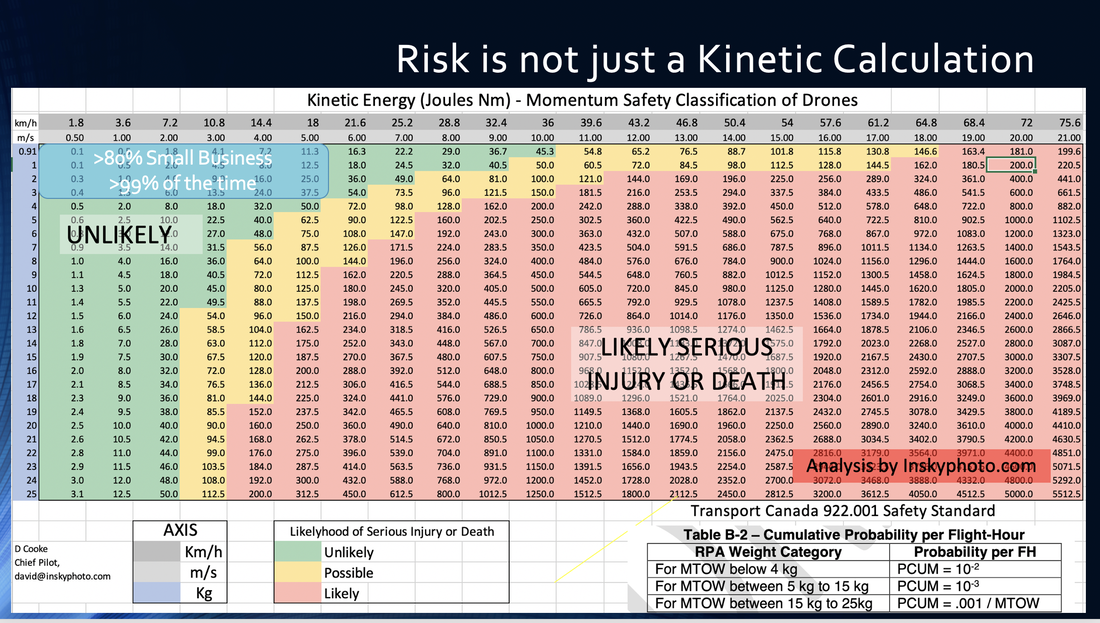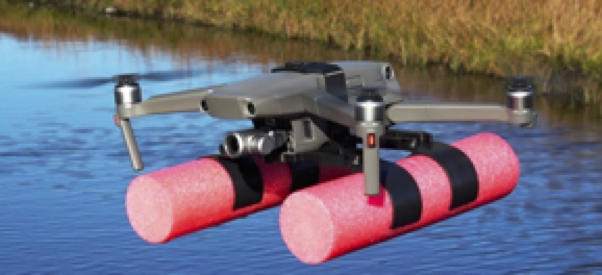Some Subtle Impacts of the new PART IX Regulations
Old weight classes have been eliminated - GOOD
New Safety Certification STD 922 is implemented that manufacturers have to follow to Self-Declare
There are 3 new weight classes under 4kg, 4 to 15kg and 15-25kg
and the difference in Kinetic energy risk between 250g and 25Kilograms is 2 orders of Magnitude (significant)
1kg "Low Kinetic Energy" LowKE aircraft should not be in the same bucket for risk analysis except overhead flight
This contributes to unnecessary restrictions not greater Flight Safety
Here is what I mean by LowKE for around 1kg 99.9% of the time the most Kinetic energy it has is about 50 joules, when flying less than 2-3 m/s. Way less than needed to kill a person even in the most unlikely scenario. Most small businesses fly DJI or similar 1-2kg equipment on tasks at less than 1m/s or hovering more than 5m from people. So the only serious "realistic" UAV risk is overflight using a 4 engine machine that if 1 engine fails it could fall on someone's head. In that case a 1kg drone IS a risk to injury or death. A Mavic or Phantom would easily reach terminal velocity of >70km/hr (20m/s) in only 2 or 3 seconds. It makes sense to limit overflight to 2-6 rotor machines that can sustain 1 engine failure and fly away. But for all other flights RISK is a function of Equipment, Operations and Operator Skill/Knowledge
The second chart shows just where LowKE aircraft fit in the Kinetic Energy RISK category. YELLOW show where LowKE is as a function of time spent at various speeds. The thin RED slice is the relative Kinetic Energy of that size Aircraft. So lets look at Operations and Operator Skills as the major component of risk.
New Safety Certification STD 922 is implemented that manufacturers have to follow to Self-Declare
There are 3 new weight classes under 4kg, 4 to 15kg and 15-25kg
and the difference in Kinetic energy risk between 250g and 25Kilograms is 2 orders of Magnitude (significant)
1kg "Low Kinetic Energy" LowKE aircraft should not be in the same bucket for risk analysis except overhead flight
This contributes to unnecessary restrictions not greater Flight Safety
Here is what I mean by LowKE for around 1kg 99.9% of the time the most Kinetic energy it has is about 50 joules, when flying less than 2-3 m/s. Way less than needed to kill a person even in the most unlikely scenario. Most small businesses fly DJI or similar 1-2kg equipment on tasks at less than 1m/s or hovering more than 5m from people. So the only serious "realistic" UAV risk is overflight using a 4 engine machine that if 1 engine fails it could fall on someone's head. In that case a 1kg drone IS a risk to injury or death. A Mavic or Phantom would easily reach terminal velocity of >70km/hr (20m/s) in only 2 or 3 seconds. It makes sense to limit overflight to 2-6 rotor machines that can sustain 1 engine failure and fly away. But for all other flights RISK is a function of Equipment, Operations and Operator Skill/Knowledge
The second chart shows just where LowKE aircraft fit in the Kinetic Energy RISK category. YELLOW show where LowKE is as a function of time spent at various speeds. The thin RED slice is the relative Kinetic Energy of that size Aircraft. So lets look at Operations and Operator Skills as the major component of risk.
DJI over 2/3rd of the market had DECLARED virtually all their UAVs as SAFE. This is GOOD
Any modification and a DECLARED aircraft is no longer DECLARED and now illegal to fly. NOT GOOD.
Even a 4gram STROBE LIGHT velcro'd on the side or a pair of foam floats or a neoprene "raincoat" is a MOD. NOT GOOD.
These aircraft are no longer valid Declared machines unless I negotiate with DJI engineers and get them to accept these mods. as safe . . not very likely.
Any modification and a DECLARED aircraft is no longer DECLARED and now illegal to fly. NOT GOOD.
Even a 4gram STROBE LIGHT velcro'd on the side or a pair of foam floats or a neoprene "raincoat" is a MOD. NOT GOOD.
These aircraft are no longer valid Declared machines unless I negotiate with DJI engineers and get them to accept these mods. as safe . . not very likely.
There are ONLY specific 7 reasons you can apply for an SFOC. dangerous cargo, BVLOS, Non- Canadian, over 400ft etc
None allows for even a minor modification of a "declared" a/c NOT GOOD
None allows for even a minor modification of a "declared" a/c NOT GOOD



